History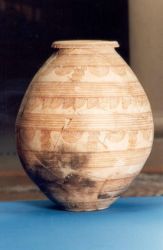
Stone Age: Remnants of former civilizations, axes, arrow tips and pieces of pottery, are found in Alcázar. Roman period: The Roman praetor Sempronius Gracus conquers the Pre-Roman city of "Alces". Some Roman mosaics from the 1st and 2nd centuries are conserved, found near the Parish Church of St. Mary, which is supposed to be built on a Roman temple. Visigothic period: No data are available from this epoch, except for the possible Visigothic architectural influences in the Parish Church of St. Mary. 711: As the rest of the Iberian Peninsula, Alcázar de San Juan succumbs to the Arabic invasion. An important fortified enclosure is built, so that the name of the city becomes "Al-kasar" ("the palace"). 1212: Reconquest of Alcázar by the Castilian King Alphonsus VIII (winner of the famous battle of Navas de Tolosa, occurred in Jaén). Once rechristianized, Al-kasar receives Saint John's Military Order and is repopulated with inhabitants of Consuegra. It comes to be named "Alcázar de Consuegra". 1226: St. Mary's Church becomes a Parish Church and is handed over to Saint John's Order. 1285: The future Ferdinand IV the "Positioned" ("Emplazado" in Spanish), heir to King Sancho IV the Brave, is born in Alcázar when the Royal Family of Castile travels to Seville. Some sources assert wrongly that Seville is the birthplace of this Castilian monarch. 1292: King Sancho IV the Brave grants the title of Village and its coat of arms to Alcázar, as well as "Fueros" (local laws) and privileges. 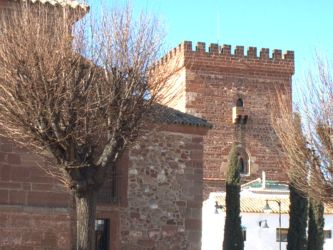
16th Century: Alcázar becomes the capital city of St. John's Priorate. The most important gunpowder factory of the Kingdom is created in Alcázar. The Parish Church of St. Mary becomes a collegiate church and the chapterhouse of St. Peter and St. Paul is created in it. 1530: Alcázar already has 18480 inhabitants. 1532: Creation of the transitioned Gothic-style Monastery of St. Francis The construction is ordered by Don Diego of Toledo, prior of St. John's Order and Duke of Alba. The University of Alcázar is founded in this monastery, with the chairs of Medicine, Theology, Sacred History and Philosophy. 1546: The University and the Council of Alcázar vow to the Virgin Mary so that she frees the city from a locust plague. As a sign, the Convent of St. Claire is built for the Clarise order of nuns. 1558: The famous writer Miguel de Cervantes Saavedra, son of Blas de Cervantes Saavedra and Catalina López, is born in Alcázar de San Juan. On November 9th he is christened in the Parish Church of St. Mary, as the baptismal certificate conserved there proves. 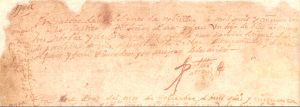
Click to enlarge the baptismal certificate of Miguel de Cervantes. 1601: The Clarise Convent of St. Joseph is founded to give shelter to the great amount of novices wishing to enter the order since the foundation of the Convent of St. Claire. 1603: A new church is built in the plot of the Parish of St. Quiteria, with plans of Juan de Herrera. 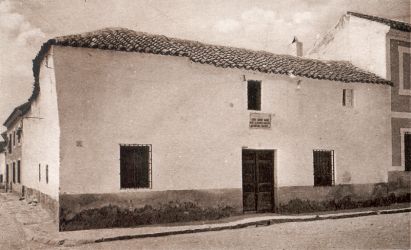
1619: Two new chairs are opened in the University of Alcázar: Grammar and Arts. 1622: The old Town Hall of Alcázar is built, taking advantage of one of the towers of the city walls. 1625: The Convent of the Holy Trinity is built. 1665-1670: Don Juan José de Austria, Phillip IV's bastard son, is kept exiled inside the Palace of St. John's Order, whose remnants are known nowadays as "Juan de Austria's Fortified Tower". 18th Century: St. John's order loses its religious character and becomes a nobility order. The priorate becomes a primogeniture of "infantes" and princes. The Great Prior's channel is built, which was an important aid to the agriculture. 1742: The collegiate Church of St. Mary is finished. 1770: The Hospital of Our Lady of the Angels is ordered to be built (where nowadays stays the Local Music School) by the "Infante" Don Gabriel de Borbón, Great Prior of St. John's Order. 1786: Alcázar, as capital city of the St. John's Order Priorate, enjoys independence, both ecclesiastical and legal, from the capital of the region, Toledo. It takes charge of 16 villages, 5 small towns, 4 castles and 11 "encomiendas". 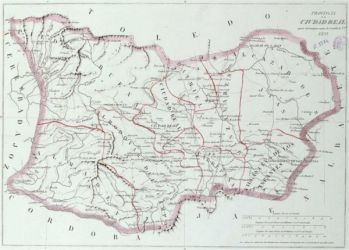
1810: The French King Joseph I, puppet of his brother Napoleon, performs a reorganization of the Spanish provinces, in which Alcázar becomes a simple town assigned to Ciudad Real (it belonged historically to Toledo). He also closes the St. John's Order Priorate, main dynamic force of the city economy during centuries. 1835: With the Disentailment of Mendizábal, the Church of St. Mary is not a collegiate any longer and the chapterhouse of St. Peter and St. Pauls disappears. The University, the Monastery of St. Francis and the Convent of the Holy Trinity disappear too. Only the Convent of St. Claire escapes from disappearing. Since then and during the 19th Century, Alcázar has lost all the splendor it once had. 1858: The Queen Isabella II opens the railway line from Madrid to Alicante, which has a stop in Alcázar. Since then, the town has become an important railway centre. 1868: The First Spanish Republic eliminates definitely the Convent of St. Claire, which becomes headquarters assigned to the Ministery of War. 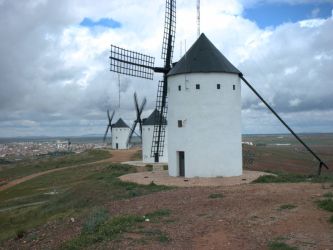
1877: Recovered again the Monarchy, the King Alphonsus XII grants the title of city to Alcázar. 1882: The Trinitary fathers come back to Alcázar and found a college. The Convent of the Immaculate Conception is also created of the Conceptionist order. 1899: The Franciscan fathers reopen the Church of St. Francis. 1929: The old Town Hall is demolished. This building dated back to 1622. Since then, the old Casino acts as Town Hall. 1954: Some excavations near the Parish Church of St. Mary show mosaics and vessels from the Roman epoch 1994: Construction of the Hospital Mancha-Centro, the most important of the centre of Castilla-La Mancha. 21st Century: Nowadays the population of Alcázar has stabilized around 28000 inhabitants. Text adapted from: http://www.alcazarweb.com/historia.asp |